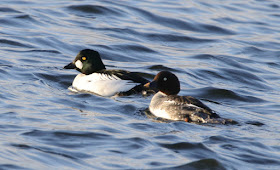At last on Friday there was a half-decent day on which to have a go at the Linnets. The day before I checked out Gulf Lane and Glasson and dropped seed at both, and then as the Linnets came back, made a count. At Glasson I counted 280+ and at Gulf Lane 130+ so the choice on Friday was to head for the least breezy place.
The site at Glasson is marginally better if there’s any wind so I met up with Andy at 0715 and we set a couple of nets.
Once again, the catch was poor, very poor, as the Linnets refused to play ball and we caught just 3 birds, 2 Reed Buntings and a single Linnet. This was despite a flock of 300+ Linnets that circled around all morning and 7 Reed Buntings in the hedgerow.
Reed Bunting
Linnet
Down in Glasson village there was a good mix of wildfowl on the marina with 19 Goldeneye, 7 Cormorant, 1 Goosander, 1 Great Crested Grebe 1 Little Grebe, 22 Tufted Duck and 35 Coot. And not forgetting 2 drake Pochard. The Pochard is now something of a rarity in these parts in comparison to early and mid-1990s when counts at Glasson Dock regularly reached into the 30s and 40s and many hundreds congregated on inland waters just north of Lancaster.
Pochard
Goldeneye
It’s not just the UK where populations of the Pochard Aythya ferina are near critical level. Nature preservation group BirdLife Finland reports that populations of the endangered Common Pochard have decreased massively in the past two decades. The organisation chose the Common Pochard to be the Bird of the Year 2018. BirdLife's calculations show that Finnish populations of the Pochard fell a staggering 80 percent in the past 20 years. The organisation hopes to help revive the species by naming it the year's top bird.
In the early 1970s the Kokemäki river delta in Satakunta bustled with some 250 pairs of Pochards.
Local calculations from a few years ago put the figure at just 30.
Technically all species of water fowl are threatened across Europe due to a number of factors, says specialist Antti J. Lind. "One of the biggest reasons is that their habitat is hugely compromised, with wetlands being dried up by industrial expansion and left to eutrophy,"
Lind says. "The Pochard needs a lot of open water to thrive." Lind also says that hunting threatened species should be prohibited.
Glasson Dock






Pochards seem to be doing OK over here at least............
ReplyDeleteGood morning Phil: Sad to hear of the perilous state of the Pochard. I think it's time to ban waterfowl hunting altogether - not that it's going to happen.
ReplyDeleteAnd those damn Linnets didn't cooperate either! Ah well, maybe next time......
Hello, your birds and photos are gorgeous. Is the Pochard the same as our Redhead duck? They look similar. The Reed Bunting is gorgeous. It is sad to hear of any population decrease in any species of bird. Thank you for linking up and sharing your post. Happy Saturday, enjoy your weekend!
ReplyDeleteGreat photos!
ReplyDeleteso relaxing this Sat walk with you
ReplyDeleteWonderful photos of our 'feathered friends' ~ my favorite is the Reed Bunting ~ sweet!
ReplyDeleteHappy Weekend to you,
A ShutterBug Explores,
aka (A Creative Harbor)
That bunting is dazzling!
ReplyDeleteIt's always diheartening to read of such low numbers of a species - like the pochard - if only more people were made aware (and care)!!
Thanks so much for letting us share a bit of your world today by linking in at I'd Rather B Birdin'.
Love the Reed Bunting! I wish better care was taken to protect endangered or threatened species. The lake is lovely!
ReplyDeleteGreat photo of the Reed Bunting. Sorry to read about the dismal reports on the other birds.
ReplyDeleteBeautiful photos here always!
ReplyDeleteThanks for sharing at https://image-in-ing.blogspot.com/2018/01/fun-with-textures-in-photoshop.html
Lovely bird images
ReplyDeleteCertainly not good news about the eutrophication of (the few) remaining wetlands.... they are so necessary to this life. One thing Florida (at least this part of it) seems to have done in the past is to require developers to create wetlands if they build on one -- there are some great birding places on created wetlands. I'm sure they aren't as good as the real thing (and I'm also pretty sure that some developers have gotten away with 'murder' .... but at least sometimes it's worked.
ReplyDeleteYour pictures are wonderful and I'm glad your weather has improved.
Hunting and environmental destruction of ecosistems produce a huge reduction of number of birds. Sad conclusions.Thank you Phil.
ReplyDeleteWe used to get 50+ Pochard on an urban reserve in Gateshead that I worked on.. I wonder how many they get now.
ReplyDeleteNice set of pictures.
Cheers - Stewart M - (back in) Melbourne
Love your photos but the lighting in that last one is stunning.
ReplyDeleteIt's tough when a species loses to humans. It can be prevented.
ReplyDeleteI'm having issues with our snowy owls. There are so many unethical birders. I'm writing about my event later, but I did see some snowy owls waiting for duck hunting on the ice.
(ツ) from Cottage Country Ontario , ON, Canada!
I'm very late this week, Phil. Sorry about the poor catches. My heart aches for the disappearance of so many species, birds or otherwise, that are disappearing from our very vulnerable planet.
ReplyDeleteI always love your buntings and linnets, but the Pochard is new to me...so sorry it has become a rarity in your area.
Hugs to you and Sue, and wishing you a bounty of birds in this new year.
Kay
An Unfittie's Guide to Adventurous Travel